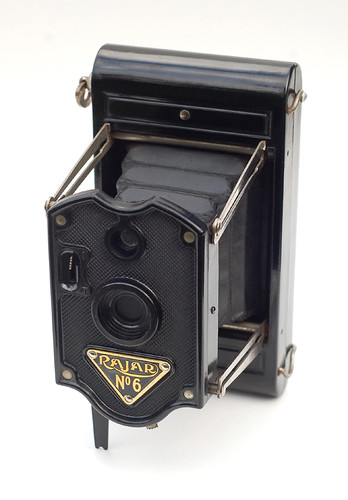Difference between revisions of "Rajar No. 6"
Hanskerensky (talk | contribs) (Added link to a Rajar No. 6 review) |
|||
| (12 intermediate revisions by 7 users not shown) | |||
| Line 1: | Line 1: | ||
{{Flickr_image | {{Flickr_image | ||
| − | |image_source= http://www.flickr.com/photos/kratz/1474222158/in/pool- | + | |image_source= http://www.flickr.com/photos/kratz/1474222158/in/pool-camerawiki/ |
|image= http://farm2.static.flickr.com/1361/1474222158_9830448a29.jpg | |image= http://farm2.static.flickr.com/1361/1474222158_9830448a29.jpg | ||
|image_align= right | |image_align= right | ||
|image_text= | |image_text= | ||
| + | |image_by= John Kratz | ||
| + | |image_rights= nc | ||
}} | }} | ||
| − | The '''Rajar No. 6''' was made by the British camera makers' group [[APM]]. Rajar Ltd. was part of that company. The No. 6 | + | The '''Rajar No. 6 folding camera''' was made by the British camera makers' group [[APM]]. Rajar Ltd. was part of that company. The No. 6 refers to Rajar's own film size. This camera was the first strut [[folding|folder]] with all three main outer parts, the body, the back and the lens standard, made of [[Bakelite]]. The camera was introduced in 1929, making it one of the first cameras made of any type of plastic. Beyond that fact it was a quite basic camera model, with meniscus lens behind an [[everset]] shutter that offers instant and time mode, film advance by key with help by a [[red window|red exposure counter window]] in the back, and a reflecting type [[viewfinder]]. The finder is mounted above the lens opening behind a hole in the lens standard, positioned to be used for vertical exposures. For horizontal exposures the lever on which the finder is mounted can be swung out so that the finder is turned 90 degrees and positioned over the standard. The shutter release lever is placed below the lens standard. The camera was a strut folder with cross-swing struts. It made 8 6×9cm exposures on special [[120_film#Rajar_No.6_film|Rajar film rolls]] for the square film drive of the camera. |
| + | {{Flickr_image | ||
| + | |image_source= http://www.flickr.com/photos/24225011@N04/2639484740/in/pool-camerawiki/ | ||
| + | |image= http://farm4.static.flickr.com/3268/2639484740_53d5760697_m.jpg | ||
| + | |image_align= right | ||
| + | |image_text= Many have an adaptor for 120 spools, fitting on<br>the square Rajar drive. Some have key winder<br />(as main picture), some (like this one) have a bar. | ||
| + | |image_by= AWCam | ||
| + | |image_rights= With permission | ||
| + | }} | ||
| + | There was also a series of [[Rajar No. 6 (box)|Rajar No.6 box cameras]]. | ||
| − | + | ==Links== | |
| − | *[http://www.americangrey. | + | *[http://www.artdecocameras.com/cameras/rajar/no.6/ Rajar No. 6 review] at [http://www.artdecocameras.com/ Art Deco Cameras] |
| + | *[http://americangrey.aminus3.com/image/2005-01-20.html images made with the Rajar No. 6] on American Grey | ||
[[Category:UK]] | [[Category:UK]] | ||
[[Category:bakelite]] | [[Category:bakelite]] | ||
[[Category:6x9 strut folding]] | [[Category:6x9 strut folding]] | ||
| + | [[Category: R]] | ||
| + | [[Category:1929]] | ||
Latest revision as of 06:54, 19 August 2021

|
| image by John Kratz (Image rights) |
The Rajar No. 6 folding camera was made by the British camera makers' group APM. Rajar Ltd. was part of that company. The No. 6 refers to Rajar's own film size. This camera was the first strut folder with all three main outer parts, the body, the back and the lens standard, made of Bakelite. The camera was introduced in 1929, making it one of the first cameras made of any type of plastic. Beyond that fact it was a quite basic camera model, with meniscus lens behind an everset shutter that offers instant and time mode, film advance by key with help by a red exposure counter window in the back, and a reflecting type viewfinder. The finder is mounted above the lens opening behind a hole in the lens standard, positioned to be used for vertical exposures. For horizontal exposures the lever on which the finder is mounted can be swung out so that the finder is turned 90 degrees and positioned over the standard. The shutter release lever is placed below the lens standard. The camera was a strut folder with cross-swing struts. It made 8 6×9cm exposures on special Rajar film rolls for the square film drive of the camera.

|
| Many have an adaptor for 120 spools, fitting on the square Rajar drive. Some have key winder (as main picture), some (like this one) have a bar. image by AWCam (Image rights) |
There was also a series of Rajar No.6 box cameras.
Links
- Rajar No. 6 review at Art Deco Cameras
- images made with the Rajar No. 6 on American Grey